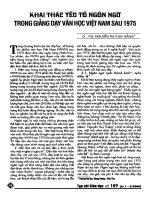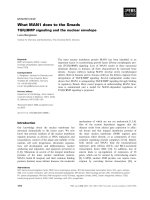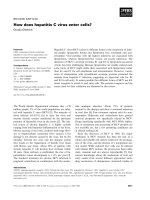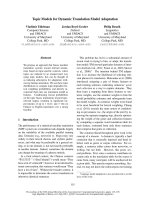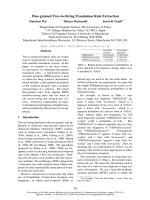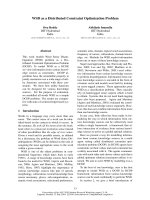Tài liệu Báo cáo khoa học: "Obfuscating Document Stylometry to Preserve Author Anonymity" pptx
Bạn đang xem bản rút gọn của tài liệu. Xem và tải ngay bản đầy đủ của tài liệu tại đây (89.06 KB, 8 trang )
Proceedings of the COLING/ACL 2006 Main Conference Poster Sessions, pages 444–451,
Sydney, July 2006.
c
2006 Association for Computational Linguistics
Obfuscating Document Stylometry to Preserve Author Anonymity
Gary Kacmarcik Michael Gamon
Natural Language Processing Group
Microsoft Research
Redmond, WA USA
{garykac,mgamon}@microsoft.com
Abstract
This paper explores techniques for reduc-
ing the effectiveness of standard author-
ship attribution techniques so that an au-
thor A can preserve anonymity for a par-
ticular document D. We discuss feature
selection and adjustment and show how
this information can be fed back to the
author to create a new document D’ for
which the calculated attribution moves
away from A. Since it can be labor inten-
sive to adjust the document in this fash-
ion, we attempt to quantify the amount of
effort required to produce the ano-
nymized document and introduce two
levels of anonymization: shallow and
deep. In our test set, we show that shal-
low anonymization can be achieved by
making 14 changes per 1000 words to
reduce the likelihood of identifying A as
the author by an average of more than
83%. For deep anonymization, we adapt
the unmasking work of Koppel and
Schler to provide feedback that allows
the author to choose the level of ano-
nymization.
1 Introduction
Authorship identification has been a long stand-
ing topic in the field of stylometry, the analysis
of literary style (Holmes 1998). Issues of style,
genre, and authorship are an interesting sub-area
of text categorization. In authorship detection it
is not the topic of a text but rather the stylistic
properties that are of interest. The writing style
of a particular author can be identified by analyz-
ing the form of the writing, rather than the con-
tent. The analysis of style therefore needs to ab-
stract away from the content and focus on the
content-independent form of the linguistic ex-
pressions in a text.
Advances in authorship attribution have raised
concerns about whether or not authors can truly
maintain their anonymity (Rao and Rohatgi
2000). While there are clearly many reasons for
wanting to unmask an anonymous author, nota-
bly law enforcement and historical scholarship,
there are also many legitimate reasons for an au-
thor to wish to remain anonymous, chief among
them the desire to avoid retribution from an em-
ployer or government agency. Beyond the issue
of personal privacy, the public good is often
served by whistle-blowers who expose wrong-
doing in corporations and governments. The loss
of an expectation of privacy can result in a chill-
ing effect where individuals are too afraid to
draw attention to a problem, because they fear
being discovered and punished for their actions.
It is for this reason that we set out to investi-
gate the feasibility of creating a tool to support
anonymizing a particular document, given the
assumption that the author is willing to expend a
reasonable amount of effort in the process. More
generally, we sought to investigate the sensitivity
of current attribution techniques to manipulation.
For our experiments, we chose a standard data
set, the Federalist Papers, since the variety of
published results allows us to simulate author-
ship attribution “attacks” on the obfuscated docu-
ment. This is important since there is no clear
consensus as to which features should be used
for authorship attribution.
2 Document Obfuscation
Our approach to document obfuscation is to
identify the features that a typical authorship at-
tribution technique will use as markers and then
adjust the frequencies of these terms to render
them less effective on the target document.
444
While it is obvious that one can affect the attri-
bution result by adjusting feature values, we
were concerned with:
• How easy is it to identify and present the
required changes to the author?
• How resilient are the current authorship
detection techniques to obfuscation?
• How much work is involved for the au-
thor in the obfuscation process?
The only related work that we are aware of is
(Rao and Rohatgi 2000) who identify the prob-
lem and suggest (somewhat facetiously, they
admit) using a round-trip machine translation
(MT) process (e.g., English → French → Eng-
lish) to obscure any traces of the original au-
thor’s style. They note that the current quality of
MT would be problematic, but this approach
might serve as a useful starting point for some-
one who wants to scramble the words a bit be-
fore hand-correcting egregious errors (taking
care not to re-introduce their style).
2.1 The Federalist Papers
One of the standard document sets used in au-
thorship attribution is the Federalist Papers, a
collection of 85 documents initially published
anonymously, but now known to have been writ-
ten by 3 authors: Alexander Hamilton, John
Madison and John Jay. Due to illness, Jay only
wrote 5 of the papers, and most of the remaining
papers are of established authorship (Hamilton =
51; Madison = 14; and 3 of joint authorship be-
tween Hamilton and Madison). The 12 remaining
papers are disputed between Hamilton and Madi-
son. In this work we limit ourselves to the 65
known single-author papers and the 12 disputed
papers.
While we refer to these 12 test documents as
“disputed”, it is generally agreed (since the work
of Mosteller and Wallace (1964)) that all of the
disputed papers were authored by Madison. In
our model, we accept that Madison is the author
of these papers and adopt the fiction that he is
interested in obscuring his role in their creation.
2.2 Problem Statement
A more formal problem statement is as follows:
We assume that an author A (in our case, Madi-
son) has created a document D that needs to be
anonymized. The author self-selects a set K of N
authors (where A
∈
K) that some future agent
(the “attacker” following the convention used in
cryptography) will attempt to select between.
The goal is to use authorship attribution tech-
niques to create a new document D’ based on D
but with features that identify A as the author
suppressed.
3 Document Preparation
Before we can begin with the process of obfus-
cating the author style in D, we need to gather a
training corpus and normalize all of the docu-
ments.
3.1 Training Corpus
While the training corpus for our example is
trivially obtained, authors wishing to anonymize
their documents would need to gather their own
corpus specific for their use.
The first step is to identify the set of authors K
(including A) that could have possibly written the
document. This can be a set of co-workers or a
set of authors who have published on the topic.
Once the authors have been selected, a suitable
corpus for each author needs to be gathered. This
can be emails or newsgroup postings or other
documents. In our experiments, we did not in-
clude D in the corpus for A, although it does not
seem unreasonable to do so.
For our example of the Federalist Papers, K is
known to be {Hamilton, Madison} and it is al-
ready neatly divided into separate documents of
comparable length.
3.2 Document Cleanup
Traditional authorship attribution techniques rely
primarily on associating idiosyncratic formatting,
language usage and spelling (misspellings, typos,
or region-specific spelling) with each author in
the study. Rao and Rohatgi (2000) and Koppel
and Schler (2003) both report that these words
serve as powerful discriminators for author attri-
bution. Thus, an important part of any obfusca-
tion effort is to identify these idiosyncratic usage
patterns and normalize them in the text.
Koppel and Schler (2003) also note that many
of these patterns can be identified using the basic
spelling and grammar checking tools available in
most word processing applications. Correcting
the issues identified by these tools is an easy first
step in ensuring the document conforms to con-
ventional norms. This is especially important for
work that will not be reviewed or edited since
these idiosyncrasies are more likely to go unno-
ticed.
445
However, there are distinctive usage patterns
that are not simple grammar or spelling errors
that also need to be identified. A well-known
example of this is the usage of while/whilst by
the authors of the Federalist Papers.
Hamilton
Madison Disputed
while
36 0 0
whilst
1 12 9
Table 1 : Occurrence counts of “while” and “whilst”
in the Federalist Papers (excluding documents au-
thored by Jay and those which were jointly authored).
In the disputed papers, “whilst” occurs in 6 of
the documents (9 times total) and “while” occurs
in none. To properly anonymize the disputed
documents, “whilst” would need to be eliminated
or normalized.
This is similar to the problem with idiosyn-
cratic spelling in that there are two ways to apply
this information. The first is to simply correct the
term to conform to the norms as defined by the
authors in K. The second approach is to incorpo-
rate characteristic forms associated with a par-
ticular author. While both approaches can serve
to reduce the author’s stylometric fingerprint, the
latter approach carries the risk of attempted style
forgery and if applied indiscriminately may also
provide clues that the document has been ano-
nymized (if strong characteristics of multiple
authors can be detected).
For our experiments, we opted to leave these
markers in place to see how they were handled
by the system. We did, however, need to normal-
ize the paragraph formatting, remove all capitali-
zation and convert all footnote references to use
square brackets (which are otherwise unused in
the corpus).
3.3 Tokenization
To tokenize the documents, we separated se-
quences of letters using spaces, newlines and the
following punctuation marks: .,()-:;`'?![]. No
stemming or morphological analysis was per-
formed. This process resulted in 8674 unique
tokens for the 65 documents in the training set.
4 Feature Selection
The process of feature selection is one of the
most crucial aspects of authorship attribution. By
far the most common approach is to make use of
the frequencies of common function words that
are content neutral, but practitioners have also
made use of other features such as letter metrics
(e.g., bi-grams), word and sentence length met-
rics, word tags and parser rewrite rules. For this
work, we opted to limit our study to word fre-
quencies since these features are generally ac-
knowledged to be effective for authorship attri-
bution and are transparent, which allows the au-
thor to easily incorporate the information for
document modification purposes.
We wanted to avoid depending on an initial
list of candidate features since there is no guaran-
tee that the attackers will limit themselves to any
of the commonly used lists. Avoiding these lists
makes this work more readily useful for non-
English texts (although morphology or stemming
may be required).
We desire two things from our feature selec-
tion process beyond the actual features. First, we
need a ranking of the features so that the author
can focus efforts on the most important features.
The second requirement is that we need a thresh-
old value so that the author knows how much the
feature frequency needs to be adjusted.
To rank and threshold the features, we used
decision trees (DTs) and made use of the readily
available WinMine toolkit (Chickering 2002).
DTs produced by WinMine for continuously val-
ued features such as frequencies are useful since
each node in the tree provides the required
threshold value. For term-ranking, we created a
Decision Tree Root (DTR) ranking metric to or-
der the terms based on how discriminating they
are. DTR Rank is computed by creating a series
of DTs where we remove the root feature, i.e. the
most discriminating feature, before creating the
next DT. In this fashion we create a ranking
based on the order in which the DT algorithm
determined that the term was most discrimina-
tory. The DTR ranking algorithm is as follows:
1) Start with a set of features
2) Build DT and record root feature
3) Remove root feature from list of features
4) Repeat from step 2
It is worth noting that the entire DT need not
be calculated since only the root is of interest.
The off-the-shelf DT toolkit could be replaced
with a custom implementation
1
that returned only
the root (also known as a decision stump). Since
1
Many DT learners are information-gain based, but
the WinMine toolkit uses a Bayesian scoring criterion
described in Chickering et al. (1997) with normal-
Wishart parameter priors used for continuously val-
ued features.
446
our work is exploratory, we did not pursue op-
timizations along these lines.
For our first set of experiments, we applied
DTR ranking starting with all of the features
(8674 tokens from the training set) and repeated
until the DT was unable to create a tree that per-
formed better than the baseline of p(Hamilton) =
78.46%. In this fashion, we obtained an ordered
list of 2477 terms, the top 10 of which are shown
in Table 2, along with the threshold and bias.
The threshold value is read directly from the DT
root node and the bias (which indicates whether
we desire the feature value to be above or below
the threshold) is determined by selecting the
branch of the DT which has the highest ratio of
non-A to A documents.
Initially, this list looks promising, especially
since known discriminating words like “upon”
and “whilst” are the top two ranked terms. How-
ever, when we applied the changes to our base-
line attribution model (described in detail in the
Evaluation section), we discovered that while it
performed well on some test documents, others
were left relatively unscathed. This is shown in
Figure 1 which graphs the confidence in assign-
ing the authorship to Madison for each disputed
document as each feature is adjusted. We expect
the confidence to start high on the left side and
move downward as more features are adjusted.
After adjusting all of the identified features, half
of the documents were still assigned to Madison
(i.e., confidence > 0.50).
Choosing just the high-frequency terms was
also problematic since most of them were not
considered to be discriminating by DTR ranking
(see Table 3). The lack of DTR rank not only
means that these are poor discriminators, but it
also means that we do not have a threshold value
to drive the feature adjustment process.
Token
DTR
Frequency
Token
DTR
Frequency
the
,
of
to
.
and
in
a
be
that
-
595
-
39
-
185
119
515
-
-
0.094227
0.068937
0.063379
0.038404
0.027977
0.025408
0.023838
0.021446
0.020139
0.014823
it
is
which
as
by
;
this
would
have
or
-
-
-
-
58
57
575
477
-
-
0.013404
0.011873
0.010933
0.008811
0.008614
0.007773
0.007701
0.007149
0.006873
0.006459
Table 3 : Top 20 terms sorted by frequency.
We next combined the DTR and the term fre-
quency approaches by computing DTR one the
set of features whose frequency exceeds a speci-
fied threshold for any one of the authors. Select-
ing a frequency of 0.001 produces a list of 35
terms, the first 14 of which are shown in Table 4.
Token
Frequency Threshold ∆ 49
upon
on
powers
there
to
men
;
by
less
in
at
those
and
any
0.002503
0.004429
0.001485
0.002707
0.038404
0.001176
0.007773
0.008614
0.001176
0.023838
0.002990
0.002615
0.025408
0.002930
> 0.003111
< 0.004312
< 0.002012
< 0.002911
> 0.039071
> 0.001531
< 0.007644
< 0.008110
< 0.001384
> 0.023574
> 0.003083
> 0.002742
< 0.025207
> 0.003005
+6
-9
0
+3
+7
+1
0
-2
-1
+6
0
+4
-1
+2
Table 4 : Top 14 DTR(0.001) ranked items. The last
column is the number of changes required to achieve
the threshold frequency for document #49.
Results for this list were much more promising
and are shown in Figure 2. The confidence of
attributing authorship to Madison is reduced by
an average of 84.42% (σ = 12.51%) and all of the
documents are now correctly misclassified as
being written by Hamilton.
Token DTR Threshold Occurrence #49
upon
whilst
on
powers
there
few
kind
consequently
wished
although
1
2
3
4
5
6
7
8
9
10
> 0.003111
< 0.000516
< 0.004312
< 0.002012
> 0.002911
< 0.000699
> 0.001001
< 0.000513
> 0.000434
< 0.000470
0 → 6
1 → 0
16 → 7
2 → 2
2 → 5
1 → 2
0 → 2
1 → 0
1 → 0
0 → 0
Table 2 : Top 10 DTR Rank ordered terms with threshold
and corresponding occurrence count (original document →
obfuscated version) for one of the disputed documents
(#49).
0.00
0.25
0.50
0.75
1.00
upon
w
h
i
l
st
on
powers
t
he
re
few
ki
n
d
conseque
ntl
y
w
ished
although
Figure 1 : Confidence in assigning disputed papers to
Madison graphed as each feature is adjusted. Each line cor-
responds to one of the 12 disputed documents. Features are
ordered by DTR Rank and the attribution model is SVM30.
Values above 0.5 are assigned to Madison and those below
0.5 are assigned to Hamilton.
447
0.00
0.25
0.50
0.75
1.00
upo
n
on
pow
ers
there
to
me
n
by
;
less
i
n
at
thos
e
and
any
Figure 2 : Confidence in assigning disputed papers to
Madison graphed as each feature is adjusted. Feature order
is DTR(0.001) and the attribution model is SVM30.
5 Evaluation
Evaluating the effectiveness of any authorship
obfuscation approach is made difficult by the
fact that it is crucially dependent on the author-
ship detection method that is being utilized. An
advantage of using the Federalist Papers as the
test data set is that there are numerous papers
documenting various methods that researchers
have used to identify the authors of the disputed
papers.
However, because of differences in the exact
data set
2
and machine learning algorithm used, it
is not reasonable to create an exact and complete
implementation of each system. For our experi-
ments, we used only the standard Federalist Pa-
pers documents and tested each feature set using
linear-kernel SVMs, which have been shown to
be effective in text categorization (Joachims
1998). To train our SVMs we used a sequential
minimal optimization (SMO) implementation
described in (Platt 1999).
The SVM feature sets that we used for the
evaluation are summarized in Table 5.
For the early experiments described in the
previous section we used SVM30, which incor-
porates the final set of 30 terms that Mosteller &
Wallace used for their study. As noted earlier,
they made use of a different data set than we did,
so we did expect to see some differences in the
results. The baseline model (plotted as the left-
most column of points in Figure 1 and Figure 2)
assigned all of the disputed papers to Madison
except one
3
.
2
Mosteller & Wallace and some others augmented the
Federalist Papers with additional document samples
(5 Hamilton and 36 Madison), but this has not been
done universally by all researchers.
3
Document #55. However, this is not inconsistent
with Mosteller &Wallace’s results: “Madison is ex-
tremely likely […] to have written all the disputed
SVM70
(Mosteller & Wallace
1964)
70 common function
words.
4
SVM30
(Mosteller & Wallace
1964)
Final 30 terms.
5
SVM11
(Tweedie, Singh &
Holmes 1996)
on, upon, there, any,
an, every, his, from,
may, can, do
SVM08
(Holmes & Forsyth
1995)
upon, both, on, there,
whilst, kind, by,
consequently
SVM03
(Bosch & Smith 1998) upon, our, are
Table 5 : Summary of feature words used in other Federal-
ist Papers studies.
5.1 Feature Modification
Rather than applying the suggested modifications
to the original documents and regenerating the
document feature vectors from scratch each time,
we simplified the evaluation process by adjusting
the feature vector directly and ignoring the im-
pact of the edits on the overall document prob-
abilities. The combination of insertions and dele-
tions results in the total number of words in the
document being increased by an average of 19.58
words (σ = 7.79), which is less than 0.5% of the
document size. We considered this value to be
small enough that we could safely ignore its im-
pact.
Modifying the feature vector directly also al-
lows us to consider each feature in isolation,
without concern for how they might interact with
each other (e.g. converting whilst→while or re-
writing an entire sentence). It also allows us to
avoid the problem of introducing rewrites into
the document with our distinctive stylometric
signature instead of a hypothetical Madison re-
write.
5.2 Experiments
We built SVMs for each feature set listed in
Table 5 and applied the obfuscation technique
described above by adjusting the values in the
feature vector by increments of the single-word
probability for each document. The results that
we obtained were the same as observed with our
test model – all of the models were coerced to
prefer Hamilton for each of the disputed docu-
ments.
Federalists […] with the possible exception of No. 55.
For No. 55 our evidence is relatively weak […].”
(Mosteller & Wallace 1964) p.263.
4
ibid p.38.
5
ibid p.66.
448
0.00
0.25
0.50
0.75
1.00
upon
o
n
powe
rs
there
t
o
men
by
;
les
s
in
a
t
t
h
ose
and
a
n
y
Figure 3 : Confidence in assigning disputed papers to
Madison graphed as each feature is adjusted. Feature order
is DTR(0.001) and the attribution model is SVM70.
Figure 3 shows the graph for SVM70, the
model that was most resilient to our obfuscation
techniques. The results for all models are sum-
marized in Table 6. The overall reduction
achieved across all models is 86.86%.
% Reduction σ
SVM70 74.66% 12.97%
SVM30 84.42% 12.51%
SVM11 82.65% 10.99%
SVM08 93.54% 4.44%
SVM03 99.01% 0.74%
Table 6 : Percent reduction in the confidence
of assigning the disputed papers to Madison
for each of the tested feature sets.
Of particular note in the results are those for
SVM03, which proved to be the most fragile
model because of its low dimension. If we con-
sider this case an outlier and remove it from
study, our overall reduction becomes 83.82%.
5.3 Feature Changes
As stated earlier, an important aspect of any ob-
fuscation approach is the number of changes re-
quired to effect the mis-attribution. Table 7
summarizes the absolute number of changes
(both insertions and deletions) and also expresses
this value related to the original document size.
The average number of changes required per
1000 words in the document is 14.2. While it is
difficult to evaluate how much effort would be
required to make each of these individual
changes, this value seems to be within the range
that a motivated person could reasonably under-
take.
More detailed summaries of the number of
feature changes required for single document
(#49) are given in Table 2 and Table 4.
By calculating the overall number of changes
required, we implicitly consider insertions and
deletions to be equally weighted. However, while
deletion sites in the document are easy to identify,
Document
Changes
Doc Size
Changes/1000
49 42 3849 10.9
50 46 2364 19.5
51 67 4039 16.6
52 52 3913 13.3
53 62 4592 13.5
54 53 4246 12.5
55 52 4310 12.1
56 59 3316 17.8
57 60 4610 13.0
58 54 4398 12.3
62 78 5048 15.5
63 91 6429 14.2
Table 7 : Changes required per document
proposing insertion sites can be more problem-
atic. We do not address this difference in this
paper, although it is clear that more investigation
is required in this area.
6 Deep Obfuscation
The techniques described above result in what
we term shallow obfuscation since they focus on
a small number of features and are only useful as
a defense against standard attribution attacks.
More advanced attribution techniques, such as
that described in (Koppel and Schler 2004) look
deeper into the author’s stylometric profile and
can identify documents that have been obfus-
cated in this manner.
Koppel and Schler introduce an approach they
term “unmasking” which involves training a se-
ries of SVM classifiers where the most strongly
weighted features are removed after each itera-
tion. Their hypothesis is that two texts from dif-
ferent authors will result in a steady and rela-
tively slow decline of classification accuracy as
features are being removed. In contrast, two texts
from the same author will produce a relatively
fast decline in accuracy. According to the authors,
a slow decline indicates deep and fundamental
stylistic differences in style - beyond the “obvi-
ous” differences in the usage of a few frequent
words. A fast decline indicates that there is an
underlying similarity once the impact of a few
superficial distinguishing markers has been re-
moved.
We repeated their experiments using 3-fold
cross-validation to compare Hamilton and Madi-
son with each other and the original (D) and ob-
fuscated (D’) documents. The small number of
documents required that we train the SVM using
the 50 most frequent words. Using a larger pool
of feature words resulted in unstable models, es-
pecially when comparing Madison (14 docu-
ments) with D and D’ (12 documents). The re-
sults of this comparison are shown in Figure 4.
449
0.3000
0.4000
0.5000
0.6000
0.7000
0.8000
0.9000
1.0000
HvD
HvD'
HvM
MvD
MvD'
Figure 4 : Unmasking the obfuscated document. The y-axis
plots the accuracy of a classifier trained to distinguish be-
tween two authors; the x-axis plots each iteration of the
unmasking process. The top three lines compare Hamilton
(H) versus Madison (M), the original document (D) and the
obfuscated document (D’). The bottom line is M vs. D and
the middle line is M vs. D’.
In this graph, the comparison of Hamilton and
the modified document (MvD’) exhibits the
characteristic curve described by Koppel and
Schler, which indicates that the original author
can still be detected. However, the curve has
been raised above the curve for the original
document which suggests that our approach does
help insulate against attacks that identify deep
stylometric features.
Modifying additional features continues this
trend and raises the curve further. Figure 5 sum-
marizes this difference by plotting the difference
between the accuracy of the HvD’ and MvD’
curves for documents at different levels of fea-
ture modification. An ideal curve in this graph
would be one that hugged the x-axis since this
would indicate that it was as difficult to train a
classifier to distinguish between M and D’ as it is
to distinguish between H and D’. In this graph,
the “0” curve corresponds to the original docu-
ment, and the “14” curve to the modified docu-
ment shown in Figure 4. The “35” curve uses all
of the DTR(0.001) features.
This graph demonstrates that using DTR rank-
ing to drive feature adjustment can produce
documents that are increasingly harder to detect
as being written by the author. While it is unsur-
prising that a deep level of obfuscation is not
achieved when only a minimal number of fea-
tures are modified, this graph can be used to
measure progress so that the author can deter-
mine enough features have been modified to
achieve the desired level of anonymization.
Equally unsurprising is that this increased ano-
nymization comes at an additional cost, summa-
rized in Table 8.
Num Features Changes/1000
7 9.9
14 14.2
21 18.3
28 22.5
35 25.1
Table 8 : Relationship between number
of features modified and corresponding
changes required per 1000 words.
While in this work we limited ourselves to the
35 DTR(0.001) features, further document modi-
fication can be driven by lowering the DTR
probability threshold to identify additional terms
in an orderly fashion.
7 Conclusion
In this paper, we have shown that the standard
approaches to authorship attribution can be con-
founded by directing the author to selectively
edit the test document. We have proposed a tech-
nique to automatically identify distinctive fea-
tures and their frequency thresholds. By using a
list of features that are both frequent and highly
ranked according to this automatic technique, the
amount of effort required to achieve reasonable
authorship obfuscation seems to be well within
the realm of a motivated author. While we make
no claim that this is an easy task, and we make
the assumption that the author has undertaken
basic preventative measures (like spellchecking
and grammar checking), it does not seem to be
an onerous task for a motivated individual.
It not surprising that we can change the out-
come by adjusting the values of features used in
authorship detection. Our contribution, however,
is that many of the important features can be de-
termined by simultaneously considering term-
frequency and DTR rank, and that this process
results in a set of features and threshold values
that are transparent and easy to control.
-0.1000
0.0000
0.1000
0.2000
0.3000
0.4000
0.5000
0
14
35
Figure 5 : Overall impact of feature modification for dif-
ferent levels of obfuscation. The y-axis plots the accuracy
delta between the HvD' and MvD' curves; the x-axis plots
each iteration of the unmasking process. The legend indi-
cates the number of features modified for each curve.
450
Given this result, it is not unreasonable to ex-
pect that a tool could be created to provide feed-
back to an author who desires to publish a docu-
ment anonymously. A sophisticated paraphrase
tool could theoretically use the function word
change information to suggest rewrites that
worked toward the desired term frequency in the
document.
For our experiments, we used a simplified
model of the document rewrite process by evalu-
ating the impact of each term modification in
isolation. However, modifying the document to
increase or decrease the frequency of a term will
necessarily impact the frequencies of other terms
and thus affect the document's stylometric signa-
ture. Further experimentation is clearly needed in
this area needs to address the impact of this in-
terdependency.
One limitation to this approach is that it ap-
plies primarily to authors that have a reasonably-
sized corpus readily available (or easily created).
However, for situations where a large corpus is
not available, automated authorship attribution
techniques are likely to be less effective (and
thus obfuscation is less necessary) since the
number of possible features can easily exceed the
number of available documents. An interesting
experiment would be to explore how this ap-
proach applies to different types of corpora like
email messages.
We also recognize that these techniques could
be used to attempt to imitate another author’s
style. We do not address this issue other than to
say that our thresholding approach is intended to
push feature values just barely across the thresh-
old away from A rather than to mimic any one
particular author.
Finally, in these results, there is a message for
those involved in authorship attribution: simple
SVMs and low-dimensional models (like
SVM03) may appear to work well, but are far
less resilient to obfuscation attempts than Koppel
and Schler’s unmasking approach. Creating clas-
sifiers with the minimum number of features
produces a model that is brittle and more suscep-
tible to even simplistic obfuscation attempts.
8 Acknowledgements
Thanks are in order to the reviewers of earlier
drafts of this document, notably Chris Brockett
and our anonymous reviewers. In addition, Max
Chickering provided useful information regard-
ing his implementation of DTs in the WinMine
toolkit.
References
R. A. Bosch and J. A. Smith. 1998. Separating Hy-
perplanes and the Authorship of the Federalist Pa-
pers. American Mathematical Monthly, Vol. 105
#7 pp. 601-608.
D. M. Chickering, D. Heckerman and C. Meek. 1997.
A Bayesian Approach to Learning Bayesian Net-
works with Local Structure. In Proceedings of the
Thirteenth Conference on Uncertainty in Artificial
Intelligence (UAI97 Providence, RI), pp. 80-89.
D. M. Chickering. 2002. The WinMine Toolkit.
Technical Report MSR-TR-2002-103.
D. I. Holmes and R. S. Forsyth. 1995. The Federalist
Revisited: New Directions in Authorship Attribu-
tion. Literary and Linguistic Computing 10(2),
pp.111-127.
D. I. Holmes. 1998. The Evolution of Stylometry in
Humanities Scholarship. Literary and Linguistic
Computing 13(3), pp.111-117.
T. Joachims. 1998. Text Categorization with Support
Vector Machines: Learning with many Relevant
Features. In Proceedings of the 10th European
Conference on Machine Learning, pp.137-142.
M. Koppel and J. Schler. 2003. Exploiting Stylistic
Idiosyncrasies for Authorship Attribution. In Pro-
ceedings of IJCAI'03 Workshop on Computational
Approaches to Style Analysis and Synthesis (Aca-
pulco, Mexico). pp.69-72.
M. Koppel and J. Schler, 2004. Authorship Verifica-
tion as a One-Class Classification Problem. In Pro-
ceedings of the Twenty-First International Confer-
ence on Machine Learning (ICML 04 Banff, Al-
berta, Canada), pp.489-495.
F. Mosteller and D. L. Wallace. 1964. Inference and
Disputed Authorship: The Federalist. Addison-
Wesley (Reading, Massachusetts, USA).
J. Platt. 1999. Fast Training of SVMs Using Sequen-
tial Minimal Optimization. In B. Schölkopf, C.
Burges and A. Smola (eds.) Advances in Kernel
Methods: Support Vector Learning. MIT Press
(Cambridge, MA, USA), pp.185-208.
J. R. Rao and P. Rohatgi. 2000. Can Pseudonymity
Really Guarantee Privacy?, In Proceedings of the
9
th
USENIX Security Symposium (Denver, Colo-
rado, USA), pp.85-96.
F. J. Tweedie, S. Singh and D. I. Holmes. 1996. Neu-
ral Network Applications in Stylometry: The Fed-
eralist Papers. In Computers and the Humanities
30(1), pp.1-10.
451

